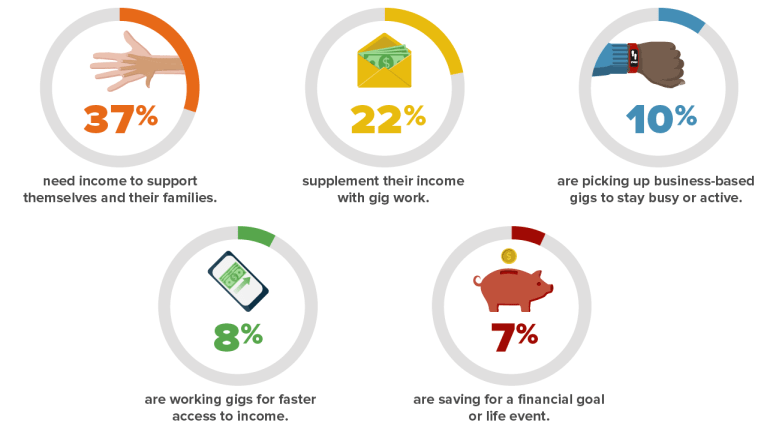ATD Blog
Gig Workers Challenge Old Order
Thu Mar 07 2019

They're creating computer code, carting food and passengers around in their own cars, and popping in monthly for a project meeting. What's their story? Are these occasional workers underemployed, unable to secure a salaried job? Are they Millennials and Generation Z-ers sampling different occupations before they commit to a career? Or Baby Boomers making some extra cash to supplement their retirement savings?
They could be any of those―or none of them. Meet the gig workers, a burgeoning population in the labor force that is changing the way company leaders look at workforce planning and the way people view work.
"As individuals have entered the workforce and evolved, they are asking for more flexibility," says Kurt Heikkinen, president and CEO of staffing company Montage. And, as access to health insurance has become increasingly separate from full-time employment, "workers have really gained a sense of freedom. They look at \[their careers\] as a series of gigs, a series of projects and experiences, as opposed to a long-term career at a given employer."
Figure 1: Gig Workers Look Like the Broader Workforce
The following charts illustrate the demographics of self-identified gig workers compared with those of the entire U.S. workforce.

Source: Morning Consult.
But these aren't the typical temp staffers of yore―the "Kelly Girl" secretaries and Manpower workers who filled in for office staff when an employer had a hole in the schedule. Nor are they limited to the classic freelancers in creative fields―writers, editors, musicians, and graphic artists. Nowadays, gig workers run the gamut, from Uber drivers to IT technicians to travel nurses. And they are an integral and growing part of the knowledge economy.
Many businesses have embraced this pipeline of on-demand talent. Yet, despite all the promise of the gig economy, it is a work in progress. The rules are still being written as companies and workers alike adjust to new ways of getting work done.
Two Types of Gig Workers
Gig work itself is not new. "People have always worked this way," but the prevalence and types of gig jobs have changed over the years, says Diane Mulcahy, author of The Gig Economy: The Complete Guide to Getting Better Work, Taking More Time Off, and Financing the Life You Want (Amacom, 2016). "This kind of work is growing at a rapid rate," she says, particularly in white-collar jobs and the tech economy.
There are two types of gig workers, Mulcahy says: first, those who are searching for full-time work and need to make some cash and contacts while they job-hunt and, second, those who simply don't want or need full-time employment.
The latter group includes a lot of younger people, for whom the idea of a 40-years-and-you-get-a-gold-watch kind of job is something their grandparents did. They aren't attracted to what they see as an outdated model of sticking with one company―or even one profession―for an extended time. But this group also includes retired or semi-retired people who may or may not need the money but who want to stay engaged and active regardless. And there are also mid-career folks who want the flexibility and freedom of doing what they want more or less when they want, drawing on years of experience to cherry-pick appealing projects.
In the United States, more than 40 percent of workers are employed in "alternative work arrangements," such as contingent, part-time, or gig work, according to Deloitte's 2018 Global Human Capital Trends study. In a 2016 Adobe survey, 56 percent of office workers predicted that everyone will do some gig work in the future. Asked to look ahead to 2020, 28 percent of business leaders and chief human resource officers said they anticipated an increase in gig workers, the Deloitte study found.
"The vast majority \[of gig workers\] are folks who easily could go get \[traditional full-time\] jobs somewhere," says Lori Williams, vice president of fulfillment at Gigster, a software developer that has 80 employees on staff and works with 1,000 gig workers. "They've chosen this lifestyle."
The top benefit of the arrangement for them is autonomy. They have greater control over their schedule and they can avoid routine annoyances such as bad managers, office politics, and interminable staff meetings. They also might learn new skills and gain valuable experience at a temporary stint, ultimately giving them the tools to advance in other gigs or in staff jobs.
Employers, too, enjoy the perks of an open relationship, gaining access to skills and talent without having to commit to a full-time hire. And managers can supplement staff with gigsters who have the talent and knowledge not only to advance a project, but to teach regular employees new skills.
"It's really \[about\] how can we continue to scale as an organization?" says Vlasta Dusil, senior vice president of HR for computer technology company SAP's Cloud Business Group. "We talk about diversity, with gender, with different generations. In our view, this is another way of looking at diversity."
Growing Pains
Still, there are some drawbacks―for both sides. The "flexible schedule" so many people crave can lead to them being underemployed. The gig worker might also miss out on the advantages that come from committing to one employer. Among those advantages is professional development.
"How are these people going to train and develop and grow?" says Jennifer Graham-Johnson, SHRM-SCP, recently retired chief HR officer at WestRock Co., a paper and packaging products manufacturer.
"I do worry we are going to have a group of people who are . . . unable to advance" if they ever decide they want full-time employment because they haven't had the opportunity to develop their skills and knowledge through training and classes.
Then there's the issue of employee benefits.
Gig workers don't get health insurance, paid time off, or 401(k) contributions from employers. Offering them the same perks that staff members get could set an employer up for legal challenges and negate savings typically associated with hiring gig workers.
It could also harm recruiting efforts. After all, good benefits are one of the selling points companies use to attract full-time talent. Why would people want to join your team as full-time employees if they can enjoy the freedom and flexibility of gig work and get the same benefits as regular employees?
The bigger issue may be that offering the same benefits to contractors and regular staff could get the company in trouble with the IRS, which has a 20-point test to determine whether workers are independent contractors or employees entitled to the employer-paid share of FICA taxes. Microsoft and other employers have had to pay millions of dollars in back taxes and damages after being sued by workers who said they were paid like independent contractors but treated like employees.
Figure 2: What Motivates Gig Workers?

Source: Shiftgig, Profile of a Gig Worker, 2018.
Playing Catch-Up
Government and businesses are lagging on other fronts related to the gig economy, too. Banks, for example, might be skittish about lending money to a potential homeowner who doesn't hold a permanent job. And gig workers don't get unemployment benefits, COBRA, or worker’s compensation.
Companies can help fill the gaps. One way is to offer voluntary benefits that are fully paid for by the worker but administered by the employer. E-commerce website Etsy, for example, has partnered with Stride Health to act as a health insurance broker for the people who create the art, jewelry, and other items sold on Etsy.
Still, the gig economy is clearly moving faster than the institutions that deal with these workers.
"I don't think we've caught up to this type of worker," says Arthur Tacchino, chief innovation officer at the compliance technology company SyncStream Solutions. "The workforce is changing. So how are the coverage, insurance, and benefits going to evolve to fit the newer kind of workforce we are seeing?" There's no clear to answer that, Tacchino says.
"Regulators and courts are trying to apply 20th-century law onto a 21st-century problem," says Richard Meneghello, an employment attorney and partner at Fisher Phillips. "Our hope is that once people realize it's not just a passing fad, regulators and legislators will get more serious."
One agency trying to change with the times is the Securities and Exchange Commission, which is taking a fresh look at compensation for gig workers. The agency is considering revising its rules to make it easier for people who are classified as independent contractors to receive stock awards from the companies that employ them, the New York Times reported.
While governments and financial institutions adjust, the market for gig workers is maturing, fueled by technology platforms that help both sides of the work arrangement find each other. Online labor platforms such as Upwork, Gigster, TaskRabbit, and Freelancer are not only empowering the gig economy, but revolutionizing the way workers and companies connect.
"The technology is making the whole market more efficient," says Marion McGovern, author of Thriving in the Gig Economy (Career Press, 2017) and co-founder and former CEO of M Squared Consulting.
Upwork, for example, connects computer-industry freelancers in 170 countries to employers who need their services, charging the worker a fee of 5 percent to 20 percent of the job's pay. ShiftPixy and others hire workers (paying the employer share of payroll taxes and taking care of other compliance issues), then "lend" them to clients in the hospitality and restaurant industries. The company has an app that allows people to broadcast their availability and apply for certain shifts in their communities.
As Uber was creating its digital platform for drivers, the job market for gig work was exploding, says Scott Absher, ShiftPixy's CEO. "People are looking for ways to recobble their income," and these platforms make that more efficient, he says.
Managing the Gig
So how do today's people managers handle gig workers, follow the law, and head off potential tensions with full-time staff? Some tips:
Decide who will drive the decision-making on hiring. A simple procurement process may be enough to fill an open gig for an IT techie, while a speechwriter for a CEO will likely require input from the chief executive.
Pay people promptly. "I can't tell you how many companies are on 60- to 90-day schedules" for contracts, McGovern says. But individuals expect to be paid faster and more often.
Know the law—and do not treat gigsters like employees. In fact, don't even use the word "hire" to describe the working arrangement, advised Rebecca Cenni-Leventhal, founder and CEO of staffing and recruitment firm Atrium. People who work gigs are "engaged," not hired, she cautioned.
Protect confidential company information. This is especially important when using outside contractors for a business dealing with sensitive client information, such as health data and Social Security numbers.
Let your own staffers gig―even at your company. Since many workers crave the opportunity to learn something new, offer full-time staffers the chance to develop by giving them a gig in-house.
Keep staffers and gigsters separate, when warranted. "Having \[gig workers\] participate in regular team meetings or asking them for regular updates and reporting is not wise," says Cenni-Leventhal, as that may cause them to be viewed as employees rather than independent contractors. "Inviting them to one holiday party isn't too much of a risk, but when you start having them participate in team-building activities and attending company functions, it can get tricky."
Make your gig workers feel welcome and valued. "Make sure you afford them the correct level of respect," McGovern says. "This is someone who is going to add to the team, bringing in skills or knowledge and experience to help the effort."
On top of that, she adds, it's important to recognize the dignity of their career choice. After all, it's a work arrangement more business leaders can expect to manage in the coming years.
Copyright 2019, SHRM. This article is reprinted from www.shrm.org with permission from SHRM. All rights reserved.
